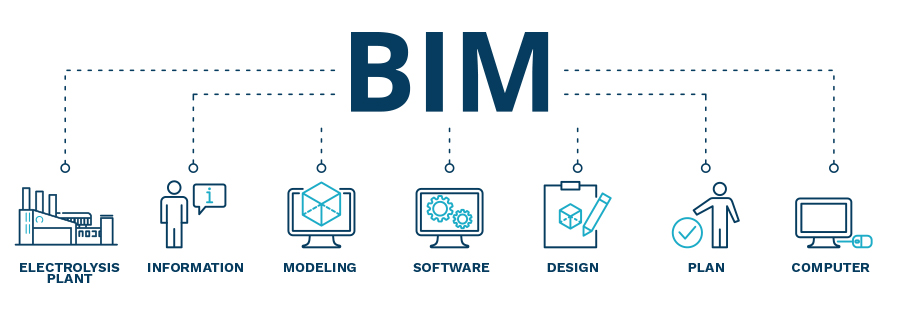Building Information Modeling (BIM) represents a transformative methodology in the fields of architecture, engineering, and construction, and is a crucial tool for innovative companies like Welysis.
As a leader in the manufacturing and installation of electrolysis plants, Welysis integrates BIM to optimize its projects from inception to completion, ensuring maximum accuracy and efficiency at every process stage. In the following sections, we will delve into what BIM is, how it functions, and explore its key components and benefits, highlighting how Welysis utilizes this advanced technology to enhance its solutions in the modern construction industry.
What is Building Information Modeling?
BIM, an acronym for Building Information Modelling (or Management), is a methodology that combines 3D modelling with a comprehensive database, centralising all relevant project information into one single digital model. As a result, all geometric, time, cost, environmental impact and maintenance data are interconnected, facilitating a continuous decision-making process from the design phase through to construction and operation.
In an industry where efficiency and accuracy are paramount, Building Information Modelling (BIM) makes it possible to anticipate problems and make necessary adjustments prior to construction, thereby optimising resources and reducing unexpected costs.
Benefits of BIM Modelling
- Improved Coordination and Clash Detection: Early detection of any potential issues in the design phase, such as conflicts between different building systems, saving time and resources during construction.
- Enhanced Accuracy: With BIM, building components can be visualized realistically, and documentation is automatically updated with every change, reducing the margin for error.
- Increased Efficiency: Streamlined workflows and the ability to track materials and progress enhance overall project efficiency and management.
- Cost Reduction: Better planning and visualization lead to more accurate budgeting and reduced waste of materials and resources.
- Sustainability: Enhanced capability to design efficient buildings with optimized energy use and lesser environmental impact.
BIM is continuously evolving, integrating more advanced technologies like AI, machine learning, and IoT, making it an indispensable tool in modern architecture, engineering, and construction industries. It represents a shift from isolated operations to a more integrated, holistic approach to construction project management.
Why does Welysis use BIM in the design of our electrolysis plants?
At Welysis we have adopted BIM as a fundamental pillar of our design and planning process, using its advantages to manage projects of a highly technical nature. Building Information Modelling (BIM) methodology allows us to centralise all of the information in one single model, which represents a significant advantage over traditional design methods based on two-dimensional plans. In this way, through BIM, we can integrate all the critical aspects of the project, starting with the geometries, layouts and configurations, up to the design, thereby guaranteeing a complete and coordinated vision.
One of the greatest benefits of BIM is its ability to identify potential interferences at an early stage, reducing the need for costly modifications during the construction phase. By working on a detailed 3D model, the Welysis team can visualise and analyse every aspect of the plant before construction begins, optimising time and resources.
At Welysis we are constantly looking for the most advanced solutions for the design and development of our electrolysis plants. BIM is not only a technological tool, but also a strategic framework that ensures the accuracy and feasibility of highly complex projects, as in the case of our plants.
The BIM system makes it possible for us to work on the distribution of the different elements in the plant, define the ideal layout for the production processes to be developed, provide the necessary technical documentation for the manufacture of the project, and subsequently allow access to the information in the form of a visual and three-dimensional database, providing an infinite number of uses once the project is fully operational. For all these reasons we apply the BIM methodology.

Key benefits of BIM building information modeling in Welysis projects
In addition to facilitating efficient planning, BIM offers us multiple benefits that lead to a more controlled and accurate implementation:
- Automatic update: For us, it is essential that any changes to the model are automatically updated in all views and sections. This allows us to reduce human error and ensure that every member of the team is always working with the latest information.
- Streamlined workflow: In Welysis, everyone involved collaborates on the same digital model. This approach eliminates problems of lack of coordination and loss of information, facilitating seamless collaboration between departments and ensuring that each phase of the project progresses smoothly.
- Reduced costs and time: By having real-time information available, each team can work in a coordinated and efficient manner. This not only saves time, but also reduces operational costs, allowing us to offer a more agile and cost-effective service.
- Full integration of the project lifecycle: From inception to delivery, BIM allows us to document and manage every detail. This facilitates complete traceability of the project and ensures that we can always maintain a holistic view.
- Detailed visualisation: Working with 3D models gives us a complete perspective of every phase and element of the project, making it easier to anticipate potential challenges and define practical solutions with greater precision.
- Advanced planning: BIM allows us to establish detailed planning and precise deadlines for each stage of the project, which is key to ensuring a structured and efficient work process.
- Real-time cost analysis: BIM methodology helps us to monitor costs throughout the development of the project, ensuring that the budget is kept under control and that we optimise every resource effectively.
- Sustainability: At Welysis, we value sustainability, and BIM allows us to analyse the environmental and social impact of our projects. In this way, we can make decisions that are aligned with our principles of economic, environmental and social responsibility.
Conclusions
For us, BIM is not just a tool; it is a methodology that enables full collaboration between all teams and disciplines. Thanks to this platform, each member of the project has immediate access to the most up-to-date information, which speeds up decision-making and minimises risks. The multidisciplinary coordination that Building Information Modeling (BIM) facilitates helps us to identify and resolve any potential issues before they become major problems.
At Welysis, we believe in the importance of concentrating our efforts early in the project. By investing in detailed planning from the outset, using Building Information Modeling (BIM) as a central data source, we can avoid additional costs and unforeseen delays. This approach allows us to develop robust and efficient projects, optimising resources from the earliest stage.





